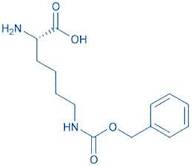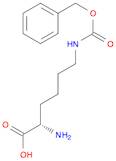CAS 1155-64-2: ε-(Benzyloxycarbonyl)-L-lysine
Description:ε-(Benzyloxycarbonyl)-L-lysine, commonly referred to as Z-L-lysine, is a derivative of the amino acid lysine, characterized by the presence of a benzyloxycarbonyl (Z) protecting group on the amino group of lysine. This modification enhances the stability and solubility of the compound, making it useful in peptide synthesis and other biochemical applications. The molecule retains the basic properties of lysine, including its basicity due to the amino group and its ability to participate in hydrogen bonding. It is typically a white to off-white crystalline solid, soluble in polar solvents like water and methanol. The compound is often utilized in the synthesis of peptides and proteins, where the Z group can be selectively removed under mild conditions, allowing for the release of the free amino group. Its CAS number, 1155-64-2, is used for identification in chemical databases. Overall, ε-(Benzyloxycarbonyl)-L-lysine serves as a valuable intermediate in organic synthesis and biochemistry.
Formula:C14H20N2O4
InChI:InChI=1S/C14H20N2O4/c15-12(13(17)18)8-4-5-9-16-14(19)20-10-11-6-2-1-3-7-11/h1-3,6-7,12H,4-5,8-10,15H2,(H,16,19)(H,17,18)/t12-/m0/s1
InChI key:InChIKey=CKGCFBNYQJDIGS-LBPRGKRZSA-N
SMILES:O=C(OCC=1C=CC=CC1)NCCCCC(N)C(=O)O
- Synonyms:
- (2S)-2-Amino-6-(phenylmethoxycarbonylamino)hexanoic acid
- (2S)-2-Amino-6-[[(benzyloxy)carbonyl]amino]hexanoic acid
- (2S)-2-ammonio-6-{[(benzyloxy)carbonyl]amino}hexanoate
- (S)-2-Amino-6-(((benzyloxy)carbonyl)amino)hexanoic acid
- <span class="text-smallcaps">L</span>-Lysine, N<sup>6</sup>-[(phenylmethoxy)carbonyl]-
- <span class="text-smallcaps">L</span>-Lysine, N<sup>6</sup>-carboxy-, N-benzyl ester
- BenzyloxycarbonylLlysine
- H-<span class="text-smallcaps">L</span>-Lys(Cbz)-OH
- H-Lys(Z)-OH
- Lys(z)
- See more synonyms
- Lysine, N<sup>6</sup>-carboxy-, N-benzyl ester
- Lysine, N<sup>6</sup>-carboxy-, N<sup>6</sup>-benzyl ester, <span class="text-smallcaps">L</span>-
- N(5)-Benzyloxycarbonyl-L-lysine
- N-6-carbobenzyloxy-L-lysine
- N-?-CBZ-L-Lysine N-?-Carbobenzyloxy-L-lysine
- N-epsilon-CBZ-L-Lysine
- N-ε-Benzoyloxycarbonyllysine
- N-ε-Carbobenzyloxyl-<span class="text-smallcaps">L</span>-Lysine
- N6-Cbz-L-lysine
- N6-benzyloxycarbonyl-L-lysine
- N<sup>6</sup>-(Benzyloxycarbonyl)-<span class="text-smallcaps">L</span>-lysine
- N<sup>6</sup>-(Phenylmethoxycarbonyl)-<span class="text-smallcaps">L</span>-lysine
- N<sup>6</sup>-Carbobenzoxy-<span class="text-smallcaps">L</span>-lysine
- N<sup>6</sup>-Carbobenzyloxy-<span class="text-smallcaps">L</span>-lysine
- N<sup>6</sup>-Carboxylysine N<sup>6</sup>-benzyl ester
- N<sup>6</sup>-[(Phenylmethoxy)carbonyl]-<span class="text-smallcaps">L</span>-lysine
- N<sup>ε</sup>-(Benzyloxycarbonyl)-<span class="text-smallcaps">L</span>-lysine
- N<sup>ε</sup>-(Benzyloxycarbonyl)lysine
- N<sup>ε</sup>-Carbobenzoxy-<span class="text-smallcaps">L</span>-lysine
- Nepsilon-Benzyloxycarbonyl-L-Lysine
- N~2~-[(benzyloxy)carbonyl]-L-lysine
- Nε-Benzyloxycarbonyl-<span class="text-smallcaps">L</span>-lysine
- Z-(e)-Lysine
- ε-(Benzyloxycarbonyl)-<span class="text-smallcaps">L</span>-lysine
- ε-N-Carbobenzyloxy-<span class="text-smallcaps">L</span>-lysine
- L-Lysine, N6-[(phenylmethoxy)carbonyl]-
- Lysine, N6-carboxy-, N6-benzyl ester, L-
- L-Lysine, N6-carboxy-, N-benzyl ester
- Lysine, N6-carboxy-, N-benzyl ester
- N6-[(Phenylmethoxy)carbonyl]-L-lysine



































